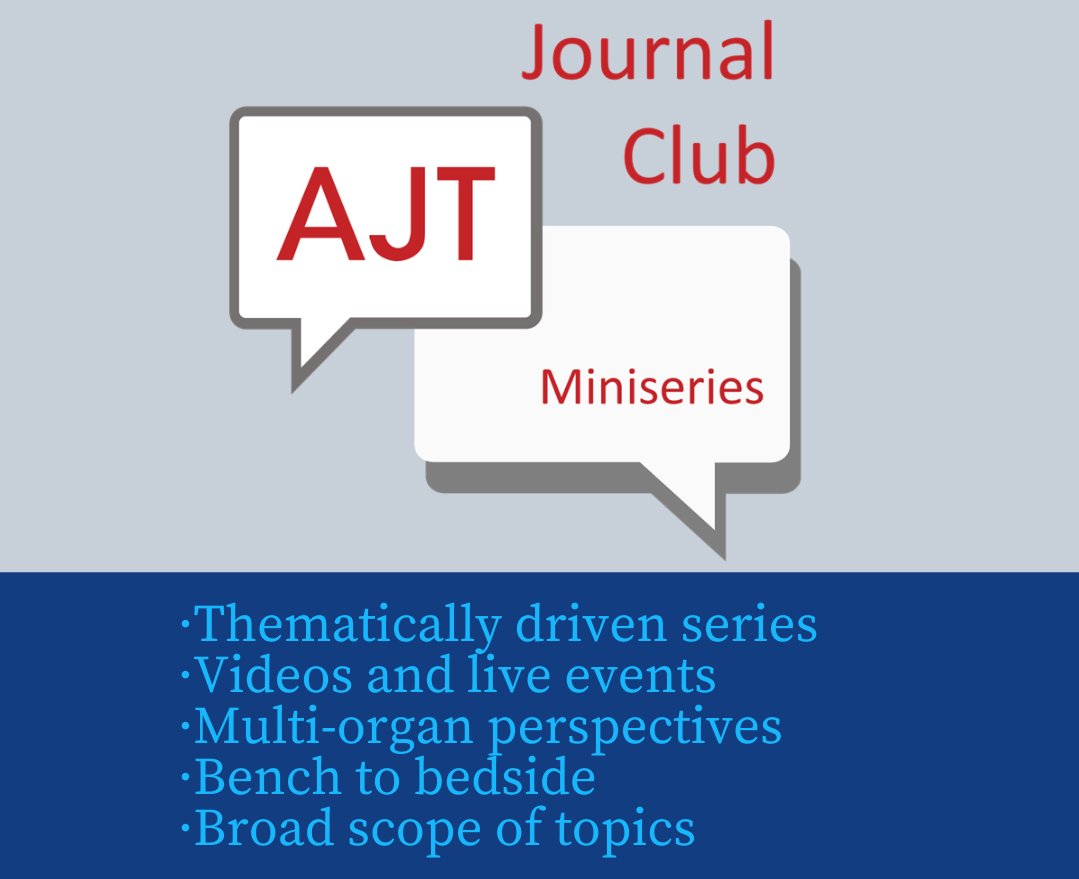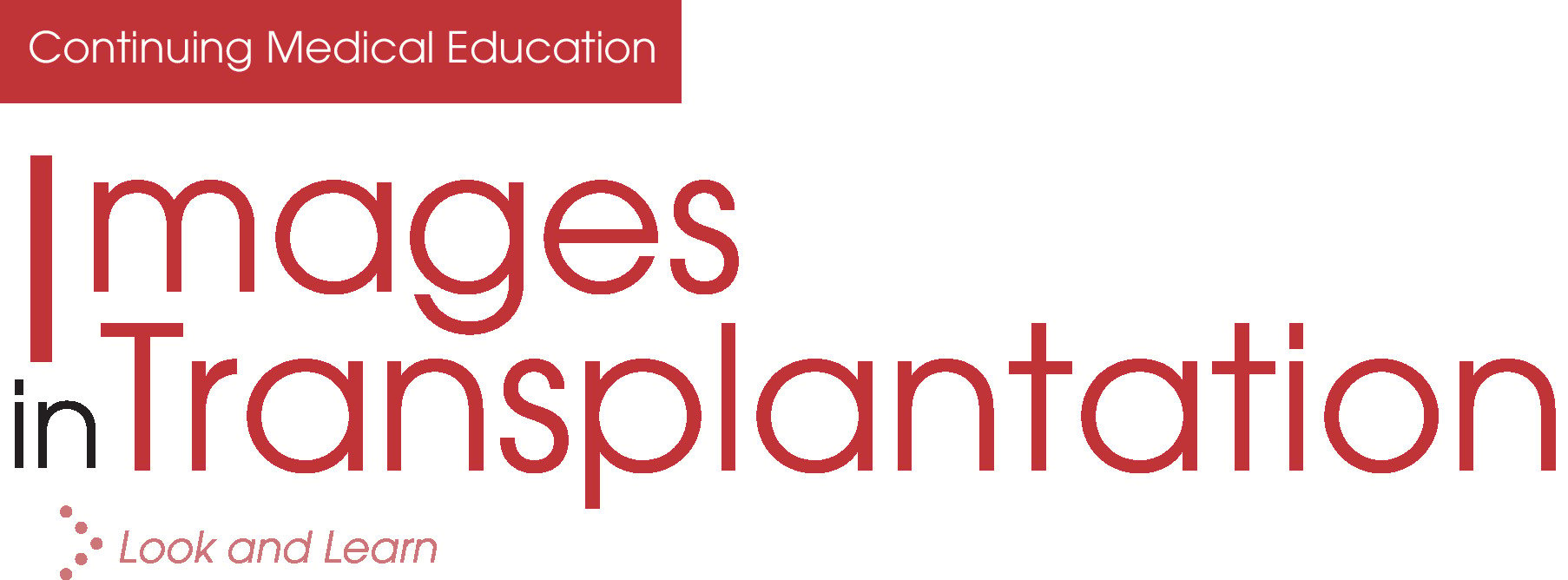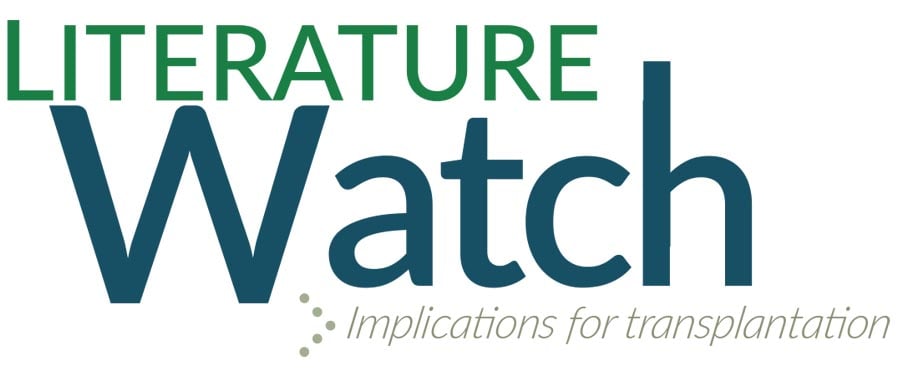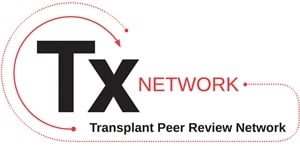Journal list menu
Export Citations
Download PDFs
Cover Image
American Journal of Transplantation: Volume 15, Number 3, March 2015
- First Published: 18 February 2015
On the cover this month: Transplantation has always been viewed as a multispecialty discipline, dependent on the aggregate actions of many diverse professionals. As healthcare reform moves us to more explicitly value the actions involved in care delivery, transplant clinicians will need to determine how best to establish compensation methods that recognize the complexity of the profession. This month, Abouljoud et al (page 601) present a novel model for establishing value for the purpose of setting compensation. Also see the editorial comment by Abecassis and Pearson (page 579) and a related brief communication on transplant surgeon burnout by Jesse et al (page 772). Cover design by Ken North, North Design Group.
The AJT Report
The AJT Report
- Pages: 575-576
- First Published: 18 February 2015
Despite movement in the United States toward cost-saving bundled payments to physicians, the Centers for Medicare and Medicaid Services issued a final rule for the 2 015 Medicare Physician Fee Schedule that unbundles 10- and 90-day global payments, and that allows only zero-day payment for surgical services. This month, “The AJT Report” talks to transplant surgeons about what the new paymen t provisions mean for their practices. Also in this issue, we take a look at China's recent announcement that it has ceased the use of organs from executed prisoners effective this year, a policy met with both support and skepticism from the transplant community.
Literature Watch
Literature Watch Implications for transplantation
- Page: 577
- First Published: 18 February 2015
New data reveal phenotypic differences in self-renewing vs. antibody-producing memory B cells.
Editorials
Fee-for-Value and wRVU-Based Physician Productivity—An Emerging Paradox
- Pages: 579-580
- First Published: 18 February 2015
Physician productivity and compensation face a paradox in the era of fee-for-value care delivery. See personal viewpoint by Abouljoud et al on page 601.
Share 35: A Liver in Time Saves Lives?
- Pages: 581-582
- First Published: 18 February 2015
Although the initial experience with Share 35 liver allocation has enhanced regional sharing for sick liver transplant candidates while increasing organ utilization and national transplant volume, potential costs with regard to system efficiency and the impact on mid- to long-term posttransplant outcomes remain to be delineated. See article by Massie et al on page 659.
Firmly Tilting the Balance of Clinical Transplant Immunity Toward Tolerance
- Pages: 583-584
- First Published: 18 February 2015
The results achieved in the Stanford trial (Scandling et al, page 695), if confirmed, suggest that our community should reconsider long-held views on the adjunctive role of donor hematopoietic transplant–based strategies in clinical organ transplantation.
Minireviews
Rotavirus in Organ Transplantation: Drug-Virus-Host Interactions
- Pages: 585-593
- First Published: 18 February 2015
This study reviews the clinical impact of rotavirus infection in the setting of organ transplantation and disseminates the interactions among the virus, host, and immunosuppressive medications.
The Putative Role of Mast Cells in Lung Transplantation
- Pages: 594-600
- First Published: 18 February 2015
The author defines the role of mast cells in lung transplantation and proposes mechanisms by which mast cells adapt to the immunological environment with the potential to improve transplant outcome.
Personal Viewpoint
Compensating the Transplant Professional: Time for a Model Change
- Pages: 601-605
- First Published: 18 February 2015
Original Articles
Basic Science
Optimization of Intrabone Delivery of Hematopoietic Progenitor Cells in a Swine Model Using Cell Radiolabeling with [89]zirconium
- Pages: 606-617
- First Published: 05 February 2015
The authors report a novel method of hematopoietic progenitor cell labeling and in vivo tracking, and develop a technique that utilizes real-time intramarrow pressure monitoring to optimize the retention of hematopoietic progenitor cells in the bone marrow following intrabone transplantation. See accompanying videos of dynamic 3D CT angiography in online supporting information and in the AJT Video Library.
Alginate Encapsulant Incorporating CXCL12 Supports Long-Term Allo- and Xenoislet Transplantation Without Systemic Immune Suppression
- Pages: 618-627
- First Published: 18 February 2015
An alginate microencapsulant incorporating CXCL12 acts as a T cell chemorepellent and an islet prosurvival factor that supports long-term allo- and xenoislet transplantation without systemic immune suppression in mouse models of diabetes.
Blockade of CD40–CD154 Costimulatory Pathway Promotes Long-Term Survival of Full-Thickness Porcine Corneal Grafts in Nonhuman Primates: Clinically Applicable Xenocorneal Transplantation
- Pages: 628-641
- First Published: 12 February 2015
Using a pig-to-nonhuman primate full-thickness corneal transplant model, the authors show that programmed administration of antibodies to CD154 (CD40 ligand) significantly prolongs corneal xenograft survival; markedly reduces inflammatory cellular infiltrations into the graft; almost completely blocks xenoantigen-triggered increases in Th1-associated cytokines, chemokines, and C3a in the aqueous humor; and effectively controls systemic expansion of memory T cells and anti-Gal/donor pig-specific antibodies.
Clinical Science
National Decline in Donor Heart Utilization With Regional Variability: 1995–2010
- Pages: 642-649
- First Published: 10 February 2015
In this analysis of SRTR data from 1995 to 2010, the authors find a significant decrease in donor heart acceptance for transplantation with variability between UNOS regions, suggesting the need for evidence-based criteria for donor heart evaluation and acceptance in the face of a critical organ shortage.
Outcomes After Heart Transplantation for Amyloid Cardiomyopathy in the Modern Era
- Pages: 650-658
- First Published: 03 February 2015
The authors review outcomes after heart transplantation for amyloid cardiomyopathy and discuss important aspects of patient selection and posttransplant management.
Early Changes in Liver Distribution Following Implementation of Share 35
- Pages: 659-667
- First Published: 18 February 2015
This study of the first 12 months of Share 35 shows an increase in regional sharing, decreased discard rates, decreased waitlist mortality, and no change in posttransplant length-of-stay or early posttransplant mortality. See editorial by Feng and O'Grady on page 581.
List and Liver Transplant Survival According to Waiting Time in Patients With Hepatocellular Carcinoma
- Pages: 668-677
- First Published: 03 February 2015
A prolonged waiting list time for hepatocellular carcinoma candidates does not have a negative impact in posttransplant survival.
Tacrolimus and the Risk of Solid Cancers After Liver Transplant: A Dose Effect Relationship
- Pages: 678-686
- First Published: 03 February 2015
This study reports that the risk of solid cancer after liver transplantation increases with early exposure to tacrolimus, and that there is a dose-response relationship that is independent of the smoking habits of the patients.
Postoperative Atrial Fibrillation in Liver Transplantation
- Pages: 687-694
- First Published: 05 February 2015
In adult liver transplantation, postoperative atrial fibrillation, occurring at a significant rate and being associated with poor outcomes, deserves preoperative stratification, close postoperative monitoring, and possible pharmacological prophylaxis.
Chimerism, Graft Survival, and Withdrawal of Immunosuppressive Drugs in HLA Matched and Mismatched Patients After Living Donor Kidney and Hematopoietic Cell Transplantation
- Pages: 695-704
- First Published: 18 February 2015
Complete immunosuppressive drug withdrawal without subsequent rejection was accomplished in fully HLA-matched kidney transplant patients with persistent mixed chimerism, and withdrawal is now being studied in HLA haplotype-matched patients with persistent mixed chimerism. See editorial by Thornley and Strom on page 583.
Allogeneic Hematopoietic Stem Cell Transplantation in Solid Organ Transplant Recipients: A Retrospective, Multicenter Study of the EBMT
- Pages: 705-714
- First Published: 03 February 2015
This article describes the outcomes of allogeneic hematopoietic stem cell transplantation performed in recipients of solid organ transplant for various hematologic disorders, suggesting that about 40% of patients may obtain a long-term benefit of this procedure.
Factors Related to the Development of CMV-Specific CD8+ T cell Response in CMV-Seropositive Solid Organ Transplant Candidates
- Pages: 715-722
- First Published: 03 February 2015
The authors report a model for predicting development of CMV-specific CD8+ immunity in CMV-seropositive solid organ transplant candidates and show that assessment of pretransplant CD8+ immune response to CMV is recommended in CMV-seropositive candidates with a lower probability of developing CMV-specific CD8+ T cell response, such as non-renal candidates, those under 50, or those without HLA-A1 or HLA-A2 alleles.
Cervicovaginal HPV Infection in Female Renal Transplant Recipients: An Observational, Self-Sampling Based, Cohort Study
- Pages: 723-733
- First Published: 12 February 2015
This cohort study shows epidemiological characteristics of cervicovaginal HPV infection in female renal transplant recipients by self-collected samples and identifies a substantial number of patients with occult premalignancies.
The Clinical Course of Kidney Transplant Recipients After 20 Years of Graft Function
- Pages: 734-740
- First Published: 12 February 2015
This observational study documents the clinical course of kidney transplant recipients after 20 years of graft function and demonstrates the substantial morbidity, particularly the increased incidence of cancer, that this group experiences.
Resolution of Low-Grade Proteinuria is Associated With Improved Outcomes After Renal Transplantation—A Retrospective Longitudinal Study
- Pages: 741-753
- First Published: 03 February 2015
The authors report that low-grade proteinuria, a dynamic variable, helps to risk-stratify hypertensive kidney transplant recipients, and that its regression, when followed longitudinally, is associated with improved clinical outcomes.
Baseline Donor Chronic Renal Injury Confers the Same Transplant Survival Disadvantage for DCD and DBD Kidneys
- Pages: 754-763
- First Published: 29 January 2015
This study investigating the role of “time-zero” histological assessment of baseline donor chronic kidney injury shows that high Remuzzi biopsy scores confer the same survival disadvantage for DCD as DBD kidney transplants, and suggests that a Remuzzi biopsy score of 5 represents the cut-off below which deceased-donor kidneys can be implanted singly.
Coagulation Profiles of Unexpected DCDD Donors Do Not Indicate a Role for Exogenous Fibrinolysis
- Pages: 764-771
- First Published: 05 February 2015
Thromboelastomeric studies demonstrate that all potential Maastricht category II unexpected DCDD donors suffer hyperfibrinolysis by the time death is declared, indicating that there is no role for additional fibrinolytic therapy in this setting.
Brief Communications
Determinants of Burnout Among Transplant Surgeons: A National Survey in the United States
- Pages: 772-778
- First Published: 12 February 2015
This cross-sectional study of American transplant surgeons shows elevated emotional exhaustion but low levels of depersonalization and personal accomplishment, and discusses factors that contribute to each. See related personal viewpoint by Abouljoud et al on page 601.
Posttransplant Metabolic Syndrome in the Withdrawal of Immunosuppression in Pediatric Liver Transplant Recipients (WISP-R) Pilot Trial
- Pages: 779-785
- First Published: 03 February 2015
In this pilot trial of calcineurin-inhibitor withdrawal in pediatric liver transplant recipients, complete discontinuation of immunosuppression improves glomerular filtration rate but not metabolic syndrome or its components, which are more prevalent than expected for age and obesity in both participants and historical controls.
Early and Late Complications After Liver Transplantation for Propionic Acidemia in Children: A Two Centers Study
- Pages: 786-791
- First Published: 12 February 2015
This two-center retrospective study shows an unexpected high mortality rate and wide range of complications occurring in 12 patients suffering from propionic acidemia who underwent liver transplantation over the last 20 years.
Staphylococcus via an Interaction With the ELR+ CXC Chemokine ENA-78 Is Associated With BOS
- Pages: 792-799
- First Published: 12 February 2015
Staphylococcus aureus respiratory isolation in concert with elevated bronchoalveolar lavage CXCL5 concentrations augments the risk of bronchiolitis obliterans due to their state-specific effects after lung transplantation, while pseudomonas and elevated concentrations of CXCL5 continue as significant risk factors for both bronchiolitis obliterans and death after bronchiolitis obliterans.
Kidney Transplant Recipients Carrying the CYP3A4*22 Allelic Variant Have Reduced Tacrolimus Clearance and Often Reach Supratherapeutic Tacrolimus Concentrations
- Pages: 800-805
- First Published: 14 January 2015
This study demonstrates that kidney transplant recipients who carry the CYP3A4*22 allelic variant and are low expressors of the cytochrome P450 3A4 in the liver have an increased risk of tacrolimus overexposure and need doses that are 30% lower than individuals who express the cytochrome P450 3A4.
Circulating NK-Cell Subsets in Renal Allograft Recipients With Anti-HLA Donor-Specific Antibodies
- Pages: 806-814
- First Published: 05 February 2015
This single-center prospective study of kidney transplant recipients shows that patients with detectable anti-HLA antibodies display lower proportions of NK cells and increased CD56bright and NKG2A+ subsets than patients without antibodies, the latter being more marked in cases with donor-specific antibodies.
Neutralizing BAFF/APRIL With Atacicept Prevents Early DSA Formation and AMR Development in T Cell Depletion Induced Nonhuman Primate AMR Model
- Pages: 815-822
- First Published: 12 February 2015
The authors demonstrate in a depletion-based nonhuman primate renal transplantation model that neutralizing BAFF/APRIL with atacicept decreases donor-specific antibodies and B cell numbers during active treatment, thus diminishing the overall humoral response after transplantation.
Case Reports
A Unique Case of Rituximab-Related Posterior Reversible Encephalopathy Syndrome in a Heart Transplant Recipient With Posttransplant Lymphoproliferative Disorder
- Pages: 823-826
- First Published: 03 February 2015
This case describes the need for early recognition of posterior reversible encephalopathy syndrome in a heart transplant recipient, and the importance of supportive therapy and withdrawal of causative factors.
Adoptive T Cell Immunotherapy for Treatment of Ganciclovir-Resistant Cytomegalovirus Disease in a Renal Transplant Recipient
- Pages: 827-832
- First Published: 03 February 2015
Adoptive T cell immunotherapy using cytomegalovirus-specific T cells from a donor bank is used as salvage therapy in a case of ganciclovir-resistant cytomegalovirus disease in a renal transplant recipient.
Fatal Scedosporiosis in Multiple Solid Organ Allografts Transmitted From a Nearly-Drowned Donor
- Pages: 833-840
- First Published: 29 January 2015
The authors describe their experience of one heart recipient and two kidney recipients with fatal scedosporiosis following deceased donor transplantation from the same donor, a nearly drowned victim of a suicide attempt.
Reports From the CDC: MMWR
Notes From the Field: Occupationally Acquired HIV Infection Among Health Care Workers—United States, 1985–2013
- Pages: 841-842
- First Published: 18 February 2015
Occupationally acquired HIV has been rarely reported in health care workers, and there have been no cases reported since 2008, possibly related to improved treatment/prevention strategies and technological advances.
Images in Transplantation
CME
An Unusual Case of Ischemic Nephropathy
- Pages: 843-845
- First Published: 18 February 2015
Letters to the Editor
Effect of HCV, HIV and Coinfection in Kidney Transplant Recipients: Mate Kidney Analyses: The Role of Diabetes
- Page: 846
- First Published: 18 February 2015
Response: Effect of HCV Monoinfection and HIV Coinfection in Kidney Transplant Recipients—The Role of Diabetes
- Pages: 847-848
- First Published: 18 February 2015
Effect of HCV/HIV Coinfection Versus HCV Monoinfection in Kidney Transplant Recipients
- Pages: 849-850
- First Published: 18 February 2015










.jpg)
